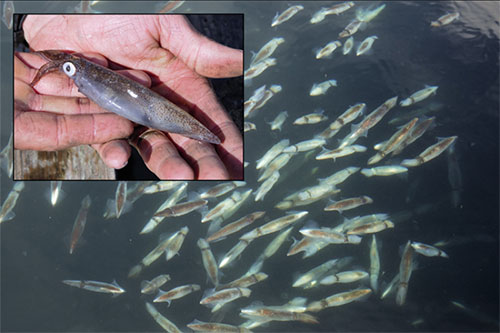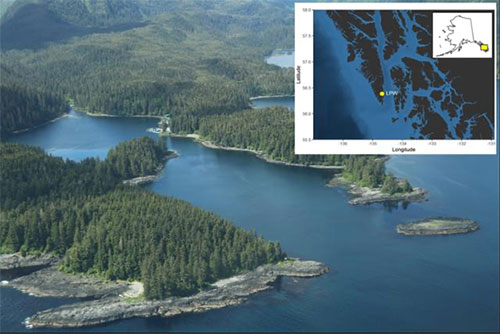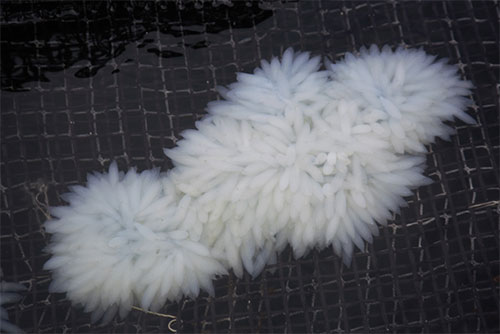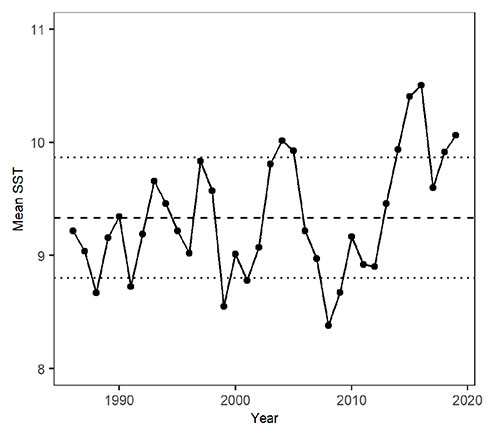Market squid at NOAA Fisheries Little Port Walter Research Station, Southeast Alaska. |
“The big question is, are they here to stay?” Eiler said. “Is this an ephemeral shift supplied each year by migration from the south? Or are market squid establishing a stable population in Southeast Alaska?”
Climate Change May be Driving A Northward TrendMarket squid, also called opalescents for their kaleidoscopic color-changing skin, inhabit nearshore waters along the Pacific coast of North America. They range from Baja California to Southeast Alaska, but are historically most abundant in the southern part of their range.
This small species is both economically and ecologically valuable. It has been California’s largest fishery by both volume and value since the 1990s. It is also an important prey species for many fish, sea birds, and marine mammals.
NOAA Fisheries Little Port Walter Research Station, located near the southern tip of Baranof Island in Southeast Alaska. |
Over the last two decades market squid have multiplied in warming waters off Oregon and Washington. This squid boom opened new opportunities for commercial fishing. The value of market squid landings in Oregon was $0 in 2015; by 2020, it rose to $6 million. As landings surged in the Pacific Northwest, they dropped in California.
The northward movement of market squid is part of a larger trend. Warming in the North Pacific has been accompanied by migration of many southern species, from plankton to predators, into subarctic and arctic waters.
Market squid populations are particularly sensitive to temperature fluctuations because of their one-year life cycle.
“If environmental conditions are unsuitable for a year or two, long-lived species can often ride it out,” Eiler explained. “Market squid are dependent on continued spawning year after year, because of their short lifespan. They spawn and die.”
Market squid egg cases laid on fish trap at NOAA Fisheries Little Port Walter Research Station, Southeast Alaska. |
Continual Migration or Established Population?
This is not the first time large numbers of market squid have appeared in Southeast Alaska. Troll fishermen saw increased abundance during warm-water El Niño events in the 1950s and 1980s.
“But after each of those events, the squid pretty much disappeared for about 20 years,” Eiler said. “What’s new this time is the fact that we have observed large numbers and spawning 4 years in a row.”
Since the late 1990s, average temperatures within the bay at Little Port Walter have remained fairly stable. However, water temperatures along the outer coast have fluctuated considerably.
Rising numbers of squid appeared at Little Port Walter following the extreme heatwave known as The Blob that began in 2013. This was followed by warm El Niño years in 2015 and 2016.
“Warm temperatures along the outer coast may have provided a thermal corridor for squid migration into Alaska from the south,” Eiler explained.
Temperatures were cold off the outer coast during 2017 and 2018. However, large numbers of squid and spawning were observed at Little Port Walter in both years.
“That suggests that the presence of squid at Little Port Walter is not just due to migration from the south,” Eiler said. “It gives credibility to the possibility that they are establishing a population in Southeast Alaska under large-scale sustained warming.”
Annual mean sea surface temperatures in marine waters off the coast of Southeast Alaska near the mouth of Chatham Strait. The horizontal dashed line represents the overall mean and the dotted lines represent one standard deviation. |
A Sentinel for Change
Eiler’s findings point to the value of long time series to detect patterns of change.
“We know about this because we’ve been monitoring the marine environment for many years,” Eiler said. “Long-term observations at Little Port Walter provide daily information on weather, freshwater and marine conditions, and changes in fauna. They provide a sentinel for changing environmental conditions.”
These changes are another example of how changes in the marine environment are impacting marine life and the communities that depend upon it. There is interest in establishing a market squid fishery in Alaska. However, Alaska Department of Fish and Game resource managers need to know if squid are really establishing local populations that can be harvested or if this is a short-term trend.
COVID temporarily halted sampling at Little Port Walter in 2020. In coming years, researchers hope to continue the work to better understand whether market squid are in Southeast Alaska to stay.
“What's the answer?” Eiler said. “Stay tuned…”
Edited By: Mary Kauffman, SitNews
Source of News:
NOAA
www.noaa.gov
Representations of fact and opinions in comments posted are solely those of the individual posters and do not represent the opinions of Sitnews.
Send a letter to the editor@sitnews.us
SitNews ©2022
Stories In The News
Ketchikan, Alaska
Articles & photographs that appear in SitNews are considered protected by copyright and may not be reprinted without written permission from and payment of any required fees to the proper freelance writers and subscription services.
E-mail your news & photos to editor@sitnews.us
Photographers choosing to submit photographs for publication to SitNews are in doing so granting their permission for publication and for archiving. SitNews does not sell photographs. All requests for purchasing a photograph will be emailed to the photographer.




